An online project under the direction of the CAPE ANN MUSEUM
inv. 66
New York Yacht Club Regatta (1)
First Regatta of the New York Yacht Club
1856 Oil on canvas 28 x 50 in. (71.1 x 127 cm) Signed and dated lower right: F H Lane 1856
|
Related Work in the Catalog
Explore catalog entries by keywords view all keywords »
Historical Materials
Below is historical information related to the Lane work above. To see complete information on a subject on the Historical Materials page, click on the subject name (in bold and underlined).
The U.S. Nautical Magazine and Naval Journal, vol. 5
pp. 16–18
Article about the New-York Yacht Club regatta held at New Bedford on August 8, 1856, as painted by Lane. Includes lists of participating yachts and times in New Bedford.
Oil on canvas
28 x 50 in.
The Preservation Society of Newport County / Collection at Chepstow (PSNC.8727)
Detail of yacht.
Filed under: Yacht & Small Pleasure Craft »
Yachting in New York Harbor had its beginnings in the early nineteenth century, largely through the efforts of John Stevens who, as a young man, built boats of his own designs with highly varied hull forms and rigs. By the early 1830s, he had others designing and building yachts to his specifications, including three notable schooners: “Wave”, “Onkahye”, and in 1844, the schooner “Gimcrack”. (Ref. 1)
It was on board “Gimcrack” that the New York Yacht Club was formally organized on July 30, 1844. The following week, the club held its first cruise – to Newport, Rhode Island. Thereafter, cruises were a regular event, with annual regattas held in New York waters or nearby ports. Newport became the most popular and enduring (to this day) vacation port for members on their summer cruises. (Ref. 2)
Perhaps the club’s most lasting mark on the world of yachting was the building of the schooner yacht “America” under the sponsorship of its members. In winning the “100 Guinea Cup”, this vessel caught the attention and respect of yacht builders and naval architects everywhere. The trophy was soon called “The America’s Cup” and became the most prestigious prize in international yachting – successfully defended by American yachts for over a century. (Ref. 3)
“America” caught Lane’s attention too. The first time was in New York late in 1850, when he saw her under construction. George Steers probably granted him access to the half model and sail plan, and from that he depicted her under sail in three views (on the same canvas). After her victory at Cowes and the publication of Dutton’s lithograph, Lane painted a copy of that image The Yacht "America" Winning the International Race, 1851 (inv. 255) with some alterations to the deck arrangement. (Ref. 4)
Growth of the club fleet was evident at its regatta at New Bedford in 1856, when eight sloops and five schooners participated to the delight of a large local audience. Lane’s depictions of the event and the vessels New York Yacht Club Regatta (1), 1856 (inv. 66) and New York Yacht Club Regatta (2), 1856 (inv. 270), coupled with Robert Bennet Forbes’s newspaper account, offer what is possibly the most complete extant visual and verbal description of an early American yacht club regatta. (Ref. 5)
New York Yacht Club’s growth was just beginning. From nine vessels in 1844, the fleet grew to eight sloops and five schooners at the New Bedford regatta. By 1860, their numbers grew to 24 sloops and 21 schooners, and by 1868 there were 13 sloops and 28 schooners. (Ref. 6)
– Erik Ronnberg
References:
1. William P. Stephens, “Traditions & Memories of American Yachting” (Camden, Maine:International Marine Publishing Co., 1981), pp. 5, 7.
2. Ibid., p. 7.
3. Ibid., pp. 8 – 10.
4. Erik A. R. Ronnberg, Jr., “Fitz Henry Lane”s ‘Yacht America’ from Three Views’: Vessel Portrait or Artist’s Concept” Antiques and Fine Art. (Summer/Autumn, 2010), pp. 174-179.
5. Robert Bennet Forbes, “Regatta at New Bedford, Massachusetts, 8 August, 1856” (Document contributed by Llewellyn Howland in The American Neptune, Vol. X, 1950), pp. 231-234.
6. Stephens, “Traditions & Memories of American Yachting”, pp. 7, 28.
The U.S. Nautical Magazine and Naval Journal, vol. 4, no. 1
pp. 464–65.
Contains brief announcement of the line-up of the August 8, 1856 race depicted by Lane.
Also filed under: "Julia" (Sloop Yacht) » // "Widgeon" (Sloop Yacht) » // Newspaper / Journal Articles » // Publications » // Regattas »
The U.S. Nautical Magazine and Naval Journal, vol. 5
pp. 16–18
Article about the New-York Yacht Club regatta held at New Bedford on August 8, 1856, as painted by Lane. Includes lists of participating yachts and times in New Bedford.
unidentified newspaper clipping
16 October 1846
Robert Bennet Forbes Scrapbook
volume 1, p.55
Phillips Library, Peabody Essex Museum (SCR 4)
Also filed under: "Northern Light" (Yacht) » // Regattas »
New Bedford is a coastal town in Massachusetts, and in the nineteenth century was one of the most important whaling ports in America. New Bedford Harbor (with New Bedford on one side and the town of Fairhaven on the other) is the estuary of the Acushnet River. The river empties into Buzzards Bay past Clarks Point, the southernmost point of the city. In 1856 the New-York Yacht Club Regatta took place in New Bedford, and Lane made several paintings of the event.
New Bedford and Old Dartmouth: A Portrait of a Region's Past, New Bedford: Old Dartmouth Historical Society, 1976.
The U.S. Nautical Magazine and Naval Journal, vol. 5
pp. 16–18
Article about the New-York Yacht Club regatta held at New Bedford on August 8, 1856, as painted by Lane. Includes lists of participating yachts and times in New Bedford.
"Emblem" was a merchant schooner, probably owned by a New Bedford merchant, recruited for the job of starting the New York Yacht Club race and monitoring the finish and the order in which each yacht crossed the finish line.
– Erik Ronnberg
The New York Yacht Club’s regatta was held in New Bedford, Massachusetts in 1856. The winner in the first class (largest yachts) was the “Julia”, owned by J. M. Waterbury, who commissioned George Steers to design and build her in 1854. Waterbury was a founding member of the New York Yacht Club, who had commissioned Steers to design and build the racing sloop “Una” for him in 1847.(Ref. 1)
Throughout the race, “Julia” led the other yachts in her class and led all other yachts in the regatta at the finish line. She is almost certainly the sloop in the left foreground of New York Yacht Club Regatta (1), 1856 (inv. 66), and while nearly identical to the sloop in the center foreground of Camden Mountains from the South Entrance to Harbor (inv. 290), the two fly very different owner’s pennants, probably the only way sloops of this design can be told apart in this series of paintings. (Ref. 2)
–Erik Ronnberg
References:
1. William P. Stephens, “Traditions & Memories of American Yachting” (Camden, Maine: International Marine Publishing Company, 1981), pp. 44, 272, 274.
2. “The U. S. Nautical Magazine, and Naval Journal” (New York: Oliver W. Griffiths, 1856). Vol. V, October, 1856 to March, 1857, pp. 15-17.
The U.S. Nautical Magazine and Naval Journal, vol. 4, no. 1
pp. 464–65.
Contains brief announcement of the line-up of the August 8, 1856 race depicted by Lane.
Also filed under: "Widgeon" (Sloop Yacht) » // New-York Yacht Club » // Newspaper / Journal Articles » // Publications » // Regattas »
The U.S. Nautical Magazine and Naval Journal, vol. 5
pp. 16–18
Article about the New-York Yacht Club regatta held at New Bedford on August 8, 1856, as painted by Lane. Includes lists of participating yachts and times in New Bedford.
The owner of "Widgeon" was the commodore of the New York Yacht Club when the vessel was racing in New Bedford in 1856. She has an unusual shape—all others had clipper bows (like Sloop with Study of Masthead Rigging, 1850s (inv. 188)). George Steers developed this kind of bow derivative of pilot schooner designs. The "Mary Taylor" is a famous example of hull type.
– Erik Ronnberg
The U.S. Nautical Magazine and Naval Journal, vol. 4, no. 1
pp. 464–65.
Contains brief announcement of the line-up of the August 8, 1856 race depicted by Lane.
Also filed under: "Julia" (Sloop Yacht) » // New-York Yacht Club » // Newspaper / Journal Articles » // Publications » // Regattas »
The U.S. Nautical Magazine and Naval Journal, vol. 5
pp. 16–18
Article about the New-York Yacht Club regatta held at New Bedford on August 8, 1856, as painted by Lane. Includes lists of participating yachts and times in New Bedford.
"Party boat" is a colloquial term for any kind of small craft adapted or used for taking guests (customarily for hire) on sightseeing trips or fishing for pleasure. (1) The term survives to this day on Cape Ann and other places for vessels engaged in the same activities. (2) In Lane's time, party boating was a calling of opportunity, and a fisherman's boat might be used in season - regularly or occasionally - to take "rusticators" fishing. Likewise, a boat used for its owner's own pleasure might be hired to take sightseers sailing for an afternoon. The latter use is seen in Lane's 1844 view of Gloucester Harbor from Rocky Neck (see the yawl-rigged sailboat in the foreground of Gloucester Harbor from Rocky Neck, 1844 (inv. 14)).
By the early 1850s, summer visitor activity, encouraged by the building of the Pavilion Hotel on Gloucester's waterfront, led to increased pleasure boating activity, if Lane's painting Gloucester Harbor, 1852 (inv. 38) of Pavilion Beach and Sidney Mason's hotel is any indication. (3) Lane's Gloucester Harbor scenes from this decade show a number of pleasure craft suitable for taking passengers for hire (see Fresh Water Cove from Dolliver's Neck, Gloucester, Early 1850s (inv. 45), Coming Ashore near Brace's Rock, Gloucester, Massachusetts, c.1860 (inv. 60), and View of Gloucester from "Brookbank," the Sawyer Homestead, c.1856 (inv. 95)). Small working craft suitable for this purpose are seen in The Old Fort and Ten Pound Island, Gloucester, 1850s (inv. 30), Gloucester Harbor, 1852 (inv. 38) (right foreground), View of Gloucester, 1859 (inv. 91) (foreground), and Watch House Point, 1860 (inv. 292) (right foreground). In View of Gloucester Harbor, 1848 (inv. 97), we see passengers boarding a small sloop-rigged boat hidden by the rocks at Duncan's Point (left middle ground).
In coastal waters south of Gloucester, a few of Lane's paintings offer pleasure craft as candidates for taking paying passengers. Phantom of Boston, c.1850s (inv. 574) depicts a cruising yawl "Phantom" of Boston, beached with hunting gear unloaded alongside while two of the crew await an approaching party in a rowing boat. The location is unidentified, but a possibility is the barrier beach around the marshes of Lynn, Massachusetts, which were once very popular hunting grounds for migrating waterfowl. A second candidate is a small sloop with a party of four on an evening sail off Halfway Rock in Becalmed Off Halfway Rock, 1860 (inv. 344) (far right).
Lane found similar uses of working watercraft in Maine, where the families of a small coastal community would travel by their workboats to a gathering place for a clambake or similar festive outing (see View of Indian Bar Cove, Brooksville, Maine, 1850 (inv. 61)). The artist became a "rusticator" himself when he, Joseph Stevens, and friends explored Mount Desert Island and vicinity in the "General Gates," a sloop-rigged Maine version of a New England Boat (View of Bar Island and Mount Desert Mountains, from the Bay in Front of Somes Settlement, 1850 (inv. 177) and Castine Harbor and Town, 1851 (inv. 272)).
When Lane traveled to New Bedford in 1856 to observe and sketch a regatta held by the New York Yacht Club, he observed and sketched it while on board an unknown vessel near the starting and finishing line, formed by the race committee boat "Emblem" and her yawl-boat.
Close by was a small party boat with observers on board, probably a fishing sloop, given its work-a-day looks. In the ensuing year, Lane painted four detailed views of this race, the party boat appearing in New York Yacht Club Regatta (1), 1856 (inv. 66) (right foreground); New York Yacht Club Regatta (2), 1856 (inv. 270) (right margin); New York Yacht Club Regatta (3), After 1856 (inv. 396) (center); and New York Yacht Club Regatta (4), 1857 (inv. 397) (left foreground). (4)
– Erik Ronnberg
References:
1. M. H. Parry and others, Aak to Zumbra: A Dictionary of the World's Watercraft (Newport News, VA: The Mariners' Museum, 2000), 436.
2. Ibid.
3. Proctor's Able Sheet (a Gloucester newspaper), January 1857: "Gloucester House reopened—refitted—boats always ready to take parties cruising or fishing..."
4. John Wilmerding, Fitz Henry Lane, 2nd ed. (Cape Ann, MA: Cape Ann Historical Association, 2005), 52–54. Lane's 1852 cruise in the Mount Desert region in the sloop "Superior" was reprinted as an appendix to Wilmerding's essay in Paintings by Fitz Hugh Lane (Washington, DC: National Gallery of Art, 1988), 125–26.
Oil on canvas
34 x 45 3/4 in.
Cape Ann Museum, Gloucester, Mass., Gift of Mrs. Jane Parker Stacy (Mrs. George O. Stacy),1948 (1289.1a)
Detail of party boat.
Also filed under: Gloucester Harbor, Inner / Harbor Cove »
Oil on canvas
22 x 36 in.
Cape Ann Museum, Gloucester, Mass., deposited by the Collection of Addison Gilbert Hospital, 1978 (DEP. 201)
Detail of party boat.
Also filed under: Ten Pound Island »
Newspaper
Ad in Gloucester Telegraph
FISHING AND SAILING PARTIES
"Persons desirous of enjoying a SAILING or FISHING EXCURSION, are informed that the subscriber will be in readiness with the Boat EUREKA, to attend to all who may favor him with their patronage. JOHN J. FERSON"
Also filed under: Gloucester Harbor – Use » // Newspaper / Journal Articles »
Newsprint
Ad for Gloucester House
Courtesy of the American Antiquarian Society, Worcester, Mass.
See p. 4, column 2.
Also filed under: Brick Houses / Gloucester House Hotel » // Newspaper / Journal Articles »
Yachts and yachting in ninteenth-century America were the preserve of the wealthy, and in Lane's early career were just beginning to organize as yacht clubs with scheduled regattas. The New York Yacht Club, founded in 1844, was the first such organization and had few rival clubs for racing or cruising until after the Civil War. (1) In Boston, by contrast, yachts of any size were few. Instead of regattas, competition was in the form of match races, between two vessels, with cash prizes as a substitute for trophies. Often, the only serious competition for a Boston-owned yacht was one of the crack pilot schooners, and it was not uncommon for a yacht to be sold for pilot service or vice-versa. (2)
If Lane had opportunity to portray any yachts in Boston, only his depiction of schooner "Northern Light" (see The Yacht "Northern Light" in Boston Harbor, 1845 (inv. 268)) has been found to date, and that was based on a drawing by Robert Salmon. (3) It seems likely that he would have depicted more Boston yachts, some of which images might still exist in private collections not currently accessible. For more depictions of yachts by Lane, we must look to New York.
Lane is known to have made two paintings of the schooner yacht "America." The more familiar one The Yacht "America" Winning the International Race, 1851 (inv. 255) was based on a lithograph derived from a painting by Oswald Brierly who witnessed and sketched "America" as she raced for the trophy that now bears her name. (4)
The other painting Yacht "America" from Three Views, c.1851 (inv. 395) was very possibly based on sketches of the designer's half-model, or even the actual vessel under construction. In either case, Lane's drawings and any notes would have been made before the hull and deck details were finalized. (5)
It would not be until August 8, 1856 that Lane would see and sketch a major yacht regatta—held by the New York Yacht Club at New Bedford, Massachusetts. From this event, he painted four known views, each depicting a different moment in the race. The earliest New York Yacht Club Regatta (3), After 1856 (inv. 396) shows the yachts under way to the starting line, with the smallest yachts (third class) starting at 10:50 a.m. The second class would start at 10:55 a.m. and the first (largest yachts) at 11:00 a.m. The second view New York Yacht Club Regatta (2), 1856 (inv. 270) shows the start of the first class; the third New York Yacht Club Regatta (4), 1857 (inv. 397), the race after the start with the large sloops and schooners taking the lead. The fourth New York Yacht Club Regatta (1), 1856 (inv. 66), depicting the finish, shows the winning sloop "Julia" over the line, lowering her racing sails, while the rest of the fleet follows her to the finish line. (6 and 7)
As interest in yachting increased, so did leisure pursuits in smaller craft, using rowing and sailing boats for rowing, fishing, and day-sailing. These activities had a commercial side which is covered in the Party Boats descriptive essay, but this essay will deal with boats used for non-commercial recreation.
Hull types and rigs for small pleasure craft were varied, some being traditional work boat designs with a few added amenities for comfort. Others were designed and built for leisure boating, often in the styles of yachts, but smaller and simpler. Among rowing boats, the dory was a logical choice, the version in View of Gloucester, (From Rocky Neck), 1846 (inv. 57) (right foreground) being smaller, with a wider bottom for greater stability. New England boats (see Norman's Woe, Gloucester Harbor, 1862 (inv. 1), View of Gloucester, 1859 (inv. 91), and Castine Harbor and Town, 1851 (inv. 272)) are also to be found in settings more akin to leisure than to work. (8)
Sailing craft custom-built for pleasure were also depicted by Lane. Examples with sloop rigs are found in The Old Fort and Ten Pound Island, Gloucester, 1850s (inv. 30) (left foreground), Fresh Water Cove from Dolliver's Neck, Gloucester, Early 1850s (inv. 45) (center left), and Coming Ashore near Brace's Rock, Gloucester, Massachusetts, c.1860 (inv. 60) (right foreground). The yawl rig is seen in View of Coffin's Beach, 1862 (inv. 41) (right middle ground), and schooners in Fresh Water Cove from Dolliver's Neck, Gloucester, Early 1850s (inv. 45) (right middle ground) and View of Gloucester, Mass., 1859 (not published) (foreground). These rigs differ only moderately from today's versions; their hull designs remain popular among admirers and owners of "traditional boats."
– Erik Ronnberg
References:
1. William P. Stephens, Traditions and Memories of American Yachting (Camden, ME: International Marine Publishing Co., 1981), 157–59.
2. Ibid., 159–61, 164–66.
3. John Wilmerding, Fitz Hugh Lane, 1804–1865: American Marine Painter (Salem, MA: Essex Institute,1964), 29–30.
4. Erik A.R. Ronnberg, Jr., "Fitz Henry Lane's Yacht America from Three Views: Vessel Portrait or Artist's Concept?," Antiques & Fine Art (Summer/Autumn 2010): 175.
5. Ibid., 174–79.
6. U.S. Nautical Magazine and Naval Journal V (October 1956–March 1857): 16–18.
7. The American Neptune X, no. 3 (July 1950): 231–34. Reprint of an unidentified newspaper account of the 1856 New Bedford Regatta by Robert Bennet Forbes.
8. See the descriptive essay on "New England Boat."
See p. 163.
Also filed under: "Northern Light" (Yacht) »
Parker & Ditson
Courtesy American Antiquarian Society, Worcester, Mass.
Dedicated to the Tiger Boat Club.
Also filed under: Bufford, J. H. Lith. – Boston » // Parker & Ditson, Pub. – Boston » // Sheet Music by other artists » // Thayer's, Lith. – Boston » // Tiger Boat Club »
The Rudder Vol. XV Part 1–3; pp. 387–390, 456–460, 483–486
"Historic American Yachts: Early Boston Vessels, The Northern Light and Coquette."
Also filed under: "Northern Light" (Yacht) »
wood, metal, cordage
Model of schooner yacht "Northern Light" of Boston, 1839
Scale 1:32
Also filed under: "Northern Light" (Yacht) » // Ship Models »
wood, metal, cordage
Model of schooner yacht "Northern Light" of Boston, 1839
Scale 1:32
Also filed under: "Northern Light" (Yacht) »
The ensign of the United States refers to the flag of the United States when used as a maritime flag to indentify nationality. As required on entering port, a vessel would fly her own ensign at the stern, but a conventional token of respect to the host country would be to fly the flag of the host country (the United States in Boston Harbor, for example) at the foremast. See The "Britannia" Entering Boston Harbor, 1848 (inv. 49) for an example of a ship doing this. The American ensign often had the stars in the canton arranged in a circle with one large star in the center; an alternative on merchant ensigns was star-shaped constellation. In times of distress a ship would fly the ensign upside down, as can be seen in Wreck of the Roma, 1846 (inv. 250).
The use of flags on vessels is different from the use of flags on land. The importance and history of the flagpole in Fresh Water Cove in Gloucester is still being studied.
The modern meaning of the flag was forged in December 1860, when Major Robert Anderson moved the U.S. garrison from Fort Moultrie to Fort Sumter in Charleston Harbor. Adam Goodheart argues this was the opening move of the American Civil War, and the flag was used throughout northern states to symbolize American nationalism and rejection of secessionism.
Before that day, the flag had served mostly as a military ensign or a convenient marking of American territory, flown from forts, embassies, and ships, and displayed on special occasions like American Independence day. But in the weeks after Major Anderson's surprising stand, it became something different. Suddenly the Stars and Stripes flew—as it does today, and especially as it did after the September 11 attacks in 2001—from houses, from storefronts, from churches; above the village greens and college quads. For the first time American flags were mass-produced rather than individually stitched and even so, manufacturers could not keep up with demand. As the long winter of 1861 turned into spring, that old flag meant something new. The abstraction of the Union cause was transfigured into a physical thing: strips of cloth that millions of people would fight for, and many thousands die for.
– Adam Goodheart, Prologue of 1861: The Civil War Awakening (2011).
Stereograph card
Cape Ann Museum Library & Archive
A view of a Cove on the western side of Gloucester Harbor, with the landing at Brookbank. Houses are seen in the woods back. A boat with two men is in the foreground.
Also filed under: Brookbank » // Fresh Water Cove » // Historic Photographs »
Courtesy American Antiquarian Society, Worcester, Mass. (CL.F9116.011.1854 CL.F9116.011.1854)
Also filed under: Oak Hall »
Courtesy American Antiquarian Society, Worcester, Mass. (CL.F9116.011.1854)
Also filed under: Oak Hall »
Clarks Point is the southernmost extension of the city of New Bedford, in Buzzards Bay, on the west side of the entrance to the Acushnet River and New Bedford Harbor. Local merchants erected the first wooden lighthouse there in 1797. This lighthouse burned down and a second was completed by 1799. Starting in 1800 the lighthouse was supported by federal funds. When it burned down a second time in 1803, it was replaced by an octagonal rubblestone tower, 38 feet tall. In 1818 it was made four feet taller and a new octagonal iron latern was added. In 1851, a new cast iron deck was added, and new lamps and reflectors were added. Starting in 1857, construction began on Fort Taber, blocking the view of the light.
There was no keeper's residence near the light. Henry M. Smith, the keeper from 1843–73, was a woodcarver of figureheads for New Bedford's whaling fleet.
This information has been shared with the Lane project by Jeremy D'Entremont. More information can be found at his website, www.newenglandlighthouses.net and The Lighthouse Handbook New England.
Sidney Mason (1799–1871) was the second of the four sons of John Mason and Phene Shipley. One of his brothers, Alphonso, was killed in the famous disaster of the burning of the steamship "Lexington." His father was master of the Gloucester workhouse, and a tavern keeper who owned the Puritan House hotel. His father, John Mason, was also the cartographer who drew the 1830/31 map of Gloucester. Lane may have been paid to color this map for sale by W.E.P. Rogers.
At the age of twelve, Sidney went to Boston, where he got a job polishing brasses. Over the course of several years, he rose to the position of clerk. In 1820, he went to the West Indies as supercargo and settled in San Juan, Puerto Rico, where he became a wealthy sugar merchant. From 1829 to 1835, he was also the first United Sates Consul in San Juan and it was there that he met and married his first wife Marequita B. Dorado. They had two children, Catalina Julia and Sidney Alphonso, and returned to live in Gloucester where Marequita died in 1835.
After her death, Sidney installed his children in American schools and embarked on an extensive tour of Europe, only returning on the death of his son in 1841. He took up residence in New York, and two years later he married Catherine Gartz Robb, a schoolmate of his daughter. She outlived him by several decades, retiring to Paris, where she ran a small hotel “frequented by the musical and artistic celebrities of the day.” (1)
His daughter Catalina married Theodorus Bailey Myers. It was their daughter, Cassie Mason Mayers, who married Julian James, and in 1913, gave to the City of Gloucester the “beautiful and interesting painting of Gloucester and its harbor painted some sixty years ago by Mr. Lane." It had previously hung in her grandfather’s New York house. (2)
In 1849, Sidney purchased a lot of land next to Pavilion Beach in Gloucester and, removing the old windmill that stood on it, built the Pavilion Hotel there. By 1850, he also owned the old family hostelry—the Atlantic House hotel (now the Blackburn Tavern) on the corner of Washington and Main Streets.
Sidney Mason owned several Lane paintings, including one of his former San Juan estate that he commissioned Lane to paint c.1850.
– Stephanie Buck (2015)
(1) Cassie Mason (Meyers) James, Biographical Sketches of the Bailey-Myers-Mason Families (Library of Congress, 1908), 48.
(2) Gloucester City Archives: Letters to City Council for July 15, 1913, #230.
Newspaper
Gloucester Telegraph
"The Cape Ann Sanitary Fair: [Held Tues–Fri in the Pavilion Hotel by favor of the owner Sidney Mason of New York] In another part of the Hall hangs a fine picture, the generous gift of our own Artist, Mr. Lane. The Subject is "Coffin's Beach," as seen from the "Loaf." This is the most costly article on sale in the rooms, and is valued at $100. It will be disposed of by tickets of $1 each."
Also filed under: Chronology » // Coffin's Beach » // Gloucester, Mass. – 1863 Sanitary Fair » // Newspaper / Journal Articles »
Newsprint
Gloucester Telegraph
Cape Ann Museum Library & Archive
At a Sanitary Fair held at the Pavilion "obtained through the favor and generosity of the owner, Mr. SIDNEY MASON, of New York, and to whom many thanks are due." "... hangs a fine picture, the generous gift of our own Artist, Mr. Lane. The Subject is "Coffin's Beach," as seen from the "Loaf." This is the most costly article on sale in the rooms, and is valued at $100. It will be disposed of by tickets $1 each."
Two paintings by Lane, Little Good Harbor Beach and View from the Loaf were on sale at the Fair.
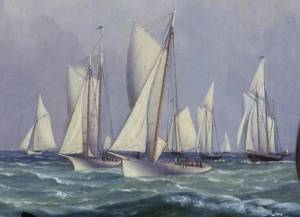


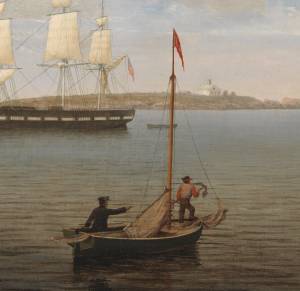
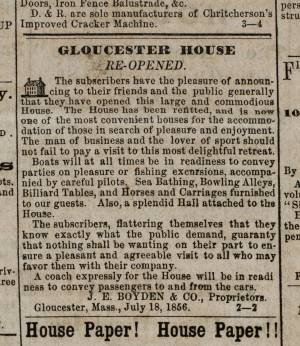
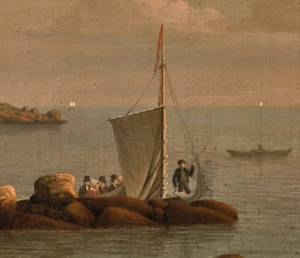
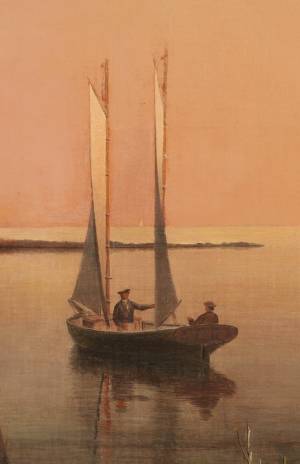



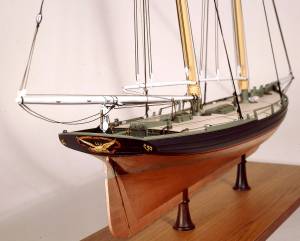
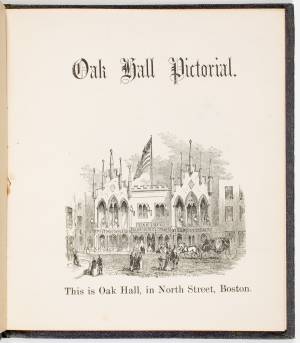
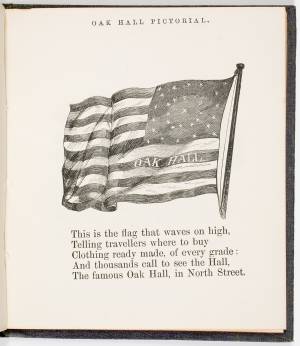
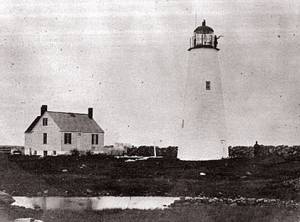
Commentary
In early August, 1856, Lane took time out from his excursion to Maine to go to New Bedford, where the New York Yacht Club was holding a regatta – its second for the season and its first in Massachusetts waters. The reasons for this expedition have not come to light, nor has any collaboration there between Lane and Bradford been found. Participants were entered in three classes based on vessel size, the smallest starting first; the largest, last. (1)
The subject of this essay’s painting is the finish of the race, the sloop “Julia” having crossed the finish line and started to lower her racing sails. Approaching the finish line (in order) are the sloop “Widgeon,” the schooner “Haze,” and the schooner “Favorita.” When time allowances were factored in, the order was “Julia” first, “America” second, and “Widgeon” third. (2)
The schooner “Emblem,” probably a working vessel in the coastal trade, was chosen to serve as the race committee boat, marking one end of the starting and finish line(s). The black dinghy to her right is anchored to mark the finish line’s other end. To the far right is a local sloop serving as a “party boat” for a small group of spectators. A far larger audience has lined the rails of the side-wheel steamer “Eagle’s Wing” at far left. A second steamer, further away in the left background, was probably also engaged to bring spectators for enjoyment of the regatta.
The regatta started at 11:00 a.m. in New Bedford Harbor, tacking out of the harbor before crossing Buzzard’s Bay close-hauled to the first stake boat off Quick’s Hole in the Elizabeth Islands. Turning briefly west-south-west toward Robinson’s Hole, the yachts then headed west toward the outer stake boat, which was anchored midway between Sow and Pigs lightship and the Old Cock spindle on Hen and Chickens Reef. From there, it was a run to New Bedford and the finish line, passing or skirting an assortment of rocks and ledges on the way. In the painting’s distant right is Clark’s Point Lighthouse at the western entrance to New Bedford Harbor – a beacon long welcomed by returning ships of New Bedford’s whaling fleet. (3)
–Erik Ronnberg
References:
1. Richard C. Kugler, “William Bradford: Sailing Ships & Arctic Seas” (Seattle, WA and London: New Bedford Whaling Museum and University of Washington Press, 2003), pp. 8, 9, 67, 103, 104, 105.
2. “The U.S. Nautical Monthly Magazine and Naval Journal”, Vol V (New York: Oliver W. Griffiths, 1856), pp. 16-18.
3. Robert Bennet Forbes, “Regatta at New Bedford, Massachusetts, 8 August, 1856” (Salem, MA: “The American Neptune”, Vol. X, 1950), pp. 231-234.
Times are taken from Robert Bennet Forbes' account of the Regatta.
[+] See More